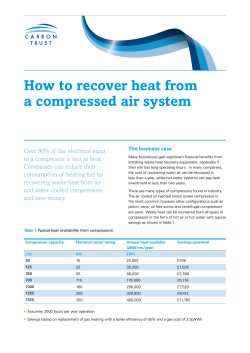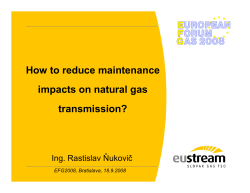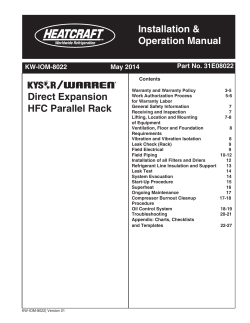
Why Compressors Fail Part 2 - Flooded Starts
MAKING MODERN LIVING POSSIBLE Why Compressors Fail Part 2 - Flooded Starts Flooded starts are probably the major cause of compressor failures. Flooded starts occur when liquid refrigerant has migrated from the system and condensed into the compressor oil. Migration can occur in all systems up to a point, due to the vapour pressure of the refrigerant being greater than the vapour pressure of the oil. It is the refrigerant vapour that migrates and then condenses into the colder compressor oil. Crankcase heaters can help prevent this problem occurring provided the heater is large enough to raise the oil temperature to at least 10°C above the ambient temperature surrounding the compressor. In cold windy environments the compressor may need an additional belt type crankcase heater plus an insulated jacket to achieve this, and tests should be carried out to confirm that the oil temperature requirements can be satisfied under all ambient temperature conditions. This compressor is fitted with both a crankcase heater and insulated jacket to help prevent refrigerant migration to the compressor oil. Insert: Here we see a belt type crankcase heater. Long OFF Cycles are also a cause of this problem, especially during the Night, and throughout the Weekends when the plant is least used, and the heat load requirements are minimal. High temperature rooms often suffer this type of failure due to very short duty cycles and lack of heat load during the winter months. NOTE The longer the OFF cycle, the greater the degree of liquid migration. The colder the oil, the greater the degree of liquid to oil migration that takes place. Failure Scenario During the OFF Cycle, when the compressor has stopped, the compressors oil temperature slowly cools down. Under situations where the surrounding ambient temperature is cold or very cold, the refrigerant vapour will start to migrate to the colder part of the system. When this is the compressor, the refrigerant vapour starts to condense inside the compressor and slowly the sump oil becomes diluted with this condensed liquid. As the oil becomes more and more saturated, some of the refrigerant will separate from the oil and lay under the oil/liquid mixture and the less diluted oil will sit above this oil/liquid layer, where it will attract even more liquid. The longer the compressor is idle, the more liquid that migrates. REFRIGERATION AND AIR CONDITIONING Field Service Note 007 Document Category Field Service Note Document title Fail : Part 2 - Flooded Starts Why Compressors Here we see refrigerant vapour starting to migrate to the colder part of the system. Which in this case is the compressor. The refrigerant vapour is now starting to condense inside the compressor and slowly the sump oil becomes diluted with liquid refrigerant. As the oil becomes more saturated some of the refrigerant has seperated from the oil and now lays beneath the oil liquid mixture and less diluted oil sits on top of this oil/liquid layer, where it will attract even more liquid. When the compressor is started, the pressure inside the compressor falls rapidly. At this point the liquid in the sump oil literally explodes out of the oil causing the crankcase to fill with refrigerant foam and oil droplets. Depending on the degree of dilution, the initial problem is that this liquid/oil mix is drawn up into the compressor’s oil ways that feed the bearings and cylinder bores etc. The system is in the off cycle, however, during this period refrigerant has migrated to the compressor and mixed with the oil. Note the pressure gauge. Once the system requires cooling and the compressor starts up there is a rapid reduction in pressure, see the gauge, and the refrigerant ‘explodes’ from the oil. The crankcase is full of refrigerant foam and oil droplets which will now be drawn into the compressor’s oil ways. As this oil/liquid mix is drawn up into the crankshaft to feed the main and big end bearing’s the heat of friction from the bearing surfaces will cause the liquid in the mix to “Flash Off” back into a vapour. This vapour will increase rapidly in its volume and prevent oil reaching the furthest bearings and con rods away from the oil pick up point. These bearings quickly run dry and overheat. Sometimes on smaller machines the main front or motor end bearing will seize and stall the motor. On larger machines the powerful motor often continues to spin the crankshaft and then the upper most con rods seize onto the crankshaft and as the crankshaft continues to 2 Liquid flash off has washed the lubrication from the bearings, in this case we can see where the con rod has seized to the bearings by welding of aluminium from the con rod to the bearing surface. In smaller compressors this type of seizure will most likely stall the motor. Lit. no. Field Service Note 007 Document Category Field Service Note Document title Fail : Part 2 - Flooded Starts Why Compressors spin, the soft aluminium con rods are snapped and the broken rods then often smash into the pistons causing a total compressor smash up. These metallic particles can be thrown around inside the machine and can damage the motor insulation and cause a spot burn or total motor burn out. Flooded starts can often be simply diagnosed by high oil levels seen in the oil level sight glass, and during the start up mode the oil is seen to foam sometimes for only a few seconds, sometimes for a few minutes. The longer the foaming lasts, the Here we see the type of damage possible with larger more powerful compressors. Due to the flash off of liquid refrigerant washing lubrication from the bearings when seizure of the con rod on the crankshaft occurs the motor continues to spin breaking the con rod. The broken con rod often smash into the piston causing further damage. more wear and damage is taking place. Engineers can easily diagnose these signs of Flood back problems, but the compressor failures can often be mistaken for Liquid Flood back or Flooded Starts as the failed components often look very similar under inspection. In extreme migration cases, this oil rich / liquid froth mixture can spill up and over into the suction gallery and into the cylinders through the suction valves. This mixture is partially Non-Compressible and often causes the suction valves to break, which can lead to broken piston crowns and damaged discharge valves and head gaskets. In these extreme cases the cause is deemed as Liquid Slugging (See Liquid Slugging ) The damage to the discharge valves, in this picture, is due to ‘Liquid Slugging’. The mixture of oil and liquid is partially non-compressible and results in broken and pitted discharge valves and even broken piston crowns. Typical Causes of Flooded Start 1) System Overcharge 2) Crankcase Temperature lower than Evaporator 3) Long Off Cycle times 4) Compressor sited in a cold windy environment 5) Crankcase heater faulty/or of insufficient power to achieve required oil temperature. 6) A, one time pump down control 7) Leaky solenoid valve Lit. no. Field Service Note 007 3 Document Category Field Service Note Document title Fail : Part 2 - Flooded Starts Why Compressors Preventative measures required 1) Use a continuous Pump Down control 2) Use a belt type crankcase heater plus insulated blanket 3) Site the compressor in a warmer ambient area Typical Damage to compressor parts. 1) Washed out bearings 2) Erratic wear to bearing surfaces 3) Seized and broken con rods 4) Main bearing seizures 5) Total smashed machine 6) Bearings near to oil pick up point in good condition. Distant bearings washed and scored 7) Liquid washed bearings always show aluminium con rod particles welded to crankshaft journal Belt type crankcase heaters for Maneurop Reciprocating Compressors Code number Voltage Output L1 L2 (V) (W) (mm) (mm) 7773106 230 55 550 7773109 110 65 7773107 230 7773117 Diameter Maneurop Minimum Maximum Reciprocating (mm) (mm) 880 180 280 650 1020 220 320 65 650 1020 220 320 400 65 650 1020 220 320 7773110 110 75 750 1160 245 370 7773108 230 75 750 1160 245 370 7773118 400 75 750 1160 245 370 Compressors MT(Z) 18 to 40 LT(Z) 22-28 MT(Z) 44 to 81 LT(Z) 40-44-50 MT(Z) 44 to 81 LT(Z) 40-44-50 MT(Z) 44 to 81 LT(Z) 40-44-50 MT(Z) 100 to 160 LT(Z) 88 to 100 MT(Z) 100 to 160 LT(Z) 88 to 100 MT(Z) 100 to 160 LT(Z) 88 to 100 Danfoss can accept no responsibility for possible errors in catalogues, brochures and other printed material. Danfoss reserves the right to alter its products without notice. This also applies to products already on order provided that such alterations can be made without subsequent changes being necessary in specifications already agreed. All trademarks in this material are property of the respective companies. Danfoss and the Danfoss logotype are trademarks of Danfoss A/S. All rights reserved. ‘Field Service Notes’ are produced by Glenn K Moore Lit. no. Field Service Note 007 4 Field Support Manager, Danfoss Ltd. E-mail glenn.moore@danfoss.com
© Copyright 2025





















